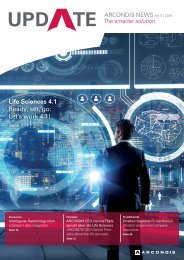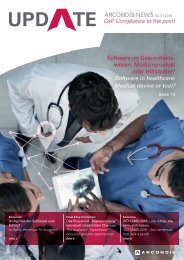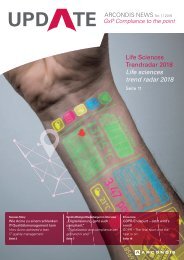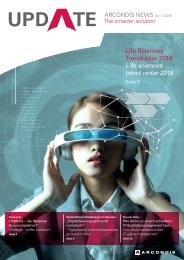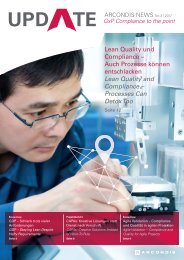ARCONDIS UPDATE No. 02|2019: The smarter solution
ARCONDIS Kundennewsletter für die Themenbereiche Business Applications und Compliance in Life Sciences Unternehmen
ARCONDIS Kundennewsletter für die Themenbereiche Business Applications und Compliance in Life Sciences Unternehmen
You also want an ePaper? Increase the reach of your titles
YUMPU automatically turns print PDFs into web optimized ePapers that Google loves.
13<br />
Klassisches V-Modell /<br />
Classic V-Model<br />
Agile Validierung /<br />
Agile Validation<br />
Validation<br />
Plan (VP)<br />
Validation<br />
Report (VR)<br />
URS<br />
URS<br />
URS<br />
User Requirement<br />
Specification<br />
(URS)<br />
Functional<br />
Specification<br />
(FS)<br />
Design<br />
Specification<br />
(DS)<br />
Unit Testing<br />
User Acceptance<br />
Testing<br />
Functional<br />
Testing<br />
VP<br />
FS<br />
DS<br />
FS<br />
DS<br />
FS<br />
DS<br />
Testing<br />
VR<br />
Release<br />
Realization<br />
1<br />
2 3 4 Sprint<br />
soll. In so einem Fall bestehe ich auf einer<br />
sehr engen Zusammenarbeit der jeweiligen<br />
Projektleiter, damit die Milestones der Projekte<br />
zusammenpassen und zum richtigen<br />
Zeitpunkt die notwendigen Anforderungen<br />
für die Entwicklung zur Verfügung stehen.<br />
Vielen Dank für den Einblick zum Vorgehen<br />
und damit zusammenhängende<br />
Besonderheiten!<br />
English<br />
E_Patrick Zahnow manages the validation<br />
and qualification team of <strong>ARCONDIS</strong> consisting<br />
of seven members. He is an expert<br />
in computerized system validation (CSV)<br />
and supervises many compliance and<br />
quality management projects as project<br />
manager and validation lead. Around 20<br />
years of experience in the pharmaceutical<br />
industry and ten years in the medical<br />
device industry have helped him become<br />
an experienced validation professional in<br />
the life sciences industry.<br />
In his interview with <strong>UPDATE</strong>, Zahnow told<br />
us about his experiences with validation<br />
projects and gave us some insights in the<br />
special challenges inherent to agile environments.<br />
Mr Zahnow, in what cases are agile CSV<br />
frameworks useful?<br />
<strong>The</strong>ir classic use is the development of<br />
mobile applications in regulated environments.<br />
But agile software development is<br />
increasingly common in the field of business<br />
applications for desktop users. It keeps the<br />
design process flexible and allows developers<br />
to focus on high-priority functions. In<br />
Scrum, for instance, functional components<br />
of an application are completed in individual<br />
iterations or ‘sprints’. To meet all quality and<br />
compliance requirements in an agile development<br />
environment, I recommend using an<br />
agile validation approach. This is also called<br />
an agile CSV framework. It facilitates collaboration<br />
between business, i.e. the specialist<br />
department, and the quality managers,<br />
increases flexibility and accelerates release<br />
cycles.<br />
When it comes to regulatory requirements,<br />
it does not matter whether you choose a<br />
traditional waterfall (V) model or go for an<br />
agile approach instead. Either way is fine. In<br />
the latter case, however, you must be very<br />
clear on which documents are meant to be<br />
released and at what stage, i.e. in which<br />
sprint.<br />
What does a typical agile framework<br />
look like?<br />
Despite what you may expect, agile validation<br />
does not mean carrying out a miniature<br />
V model in every sprint. It is enough to<br />
validate after a few sprints. In my experience,<br />
it works well to have one validation<br />
sprint after three development sprints. That<br />
is what we are currently doing with a client<br />
from the medical device industry, for whom<br />
we are launching a mobile application that<br />
enters customer feedback into the central<br />
complaint management system.<br />
In practice, all documents from the classic V<br />
model – user requirements, functional specifications,<br />
design specifications etc. – are<br />
initially established in the first sprint. During<br />
each subsequent sprint, new functions are<br />
added to these documents. <strong>The</strong> actual release<br />
and “official” testing take place during<br />
the formal validation sprint. Essentially, we<br />
take care of the left side of the V model<br />
during the development sprints, and the validation<br />
sprints correspond to the right side.<br />
What special challenges does this entail?<br />
<strong>The</strong> actual validation is similar to the<br />
standard approach, but the agile environment<br />
has some pitfalls. Getting the quality<br />
department on board before the start of the<br />
project is crucial. Unlike the waterfall model,<br />
the agile approach only gives us two to three<br />
weeks to approve all documents. If we fail to<br />
meet that deadline, the entire development<br />
is delayed by a complete sprint. This means<br />
that the approval process must be flawless.<br />
On top of the commitment of everyone<br />
responsible, a solid document management<br />
system is important.<br />
But the main challenge for any validation<br />
lead is a situation in which the developers<br />
use an agile Scrum approach, while the<br />
project managers stick to the waterfall<br />
method. That’s what is happening in one<br />
of our current projects: we are supporting<br />
a manufacturer of laboratory products in<br />
their optimization of a system. Due to strict<br />
instructions of our client, we are using the<br />
waterfall method, while an associated CRM<br />
is being developed in parallel and will have to<br />
be validated. In such cases, I insist that the<br />
project managers work very closely together.<br />
This ensures that the project milestones<br />
are compatible with each other and that the<br />
necessary requirements for the development<br />
are available at the right time.<br />
Thank you for your insight into the process<br />
and its special characteristics!



